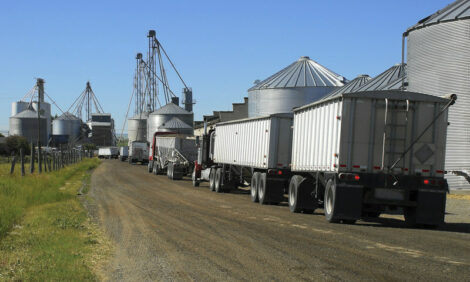



VLA: Lack of Response to Diarrhoea Antibiotics
UK - According to Defra's VLA Monthly Scanning Surveillance Report for August 2009, neonatal pigs between one to four days of age developed diarrhoea. The case has been unresponsive to antibiotics.Alimentary tract diseases
Clostridial enteritis
Approximately 20 per cent of neonatal pigs from a 180-sow breeder/finisher unit developed diarrhoea between one and four days of age. The diarrhoea was unresponsive to antibiotics but only a low group mortality was reported. Some recovered animals remained ill-thriven. Two live pigs were submitted to Thirsk for necropsy, both of which exhibited yellow faecal staining of the hindquarters. Post-mortem examination revealed mild reddening of jejunal serosa, with yellow frothy contents within the ileum which became voluminous, bubbly and bright yellow in the caecum and colon. The mesentery of the spiral colon of one pig showed marked oedema. Histopathological examination of the small intestine revealed severe villous atrophy, stunting and fusion with the ileum being particularly severely affected. Gram-positive bacilli were identifiable on gram-stained sections closely associated with surface enterocytes, confirming clostridial enteritis. Clostridial vaccination was recommended, in conjunction with increased attention to hygiene in the farrowing house.
Swine Dysentery
Six faecal samples were submitted to Thirsk for confirmation of swine dysentery in 11 to 12-week-old grower pigs. 60 animals were in the affected group and all were reported to be under-performing with a mucohaemorrhagic diarrhoea. Brachyspira hyodysenteriae was identified by PCR. Salmonella London (a group E Salmonella) was also isolated from pooled samples.
Respiratory Diseases
PRRS and Strep Suis
Bury diagnosed concurrent PRRS and Streptococcus suis infections as a cause of coughing, wasting, lameness and deaths in eight-week-old weaners from a single source on an all-in, all-out indoor nursery finisher. Approximately 55 of 550 pigs were affected with 10 deaths since the start of the problem a week earlier. Pigs had been vaccinated for Mycoplasma hyopneumoniae and sows received PCV2 vaccination.
Other diseases
Salmonella Cholerasuis
Thirsk isolated Salmonella Cholerasuis var Kunzendorf from a six-month-old gilt that died suddenly. The gilt was from a batch of pigs that was delivered to the unit two to three weeks previously. This Salmonella was a group C1 and is currently a rare isolate in the UK with only six cultures from only four holdings having been reported in pigs since 1999.
Staphylococcal arthritis
Bury investigated lameness affecting 10 to 15 per cent of piglets in farrowing houses from around 14 days of age, some of which never recovered completely following antibiotic treatment. Four live pigs were submitted with chronic arthritis mainly affecting hock and elbow joints. Staphylococcus hyicus was isolated in sparse but pure growth from three affected joints. There was no evidence of greasy pig disease in the submitted pigs, although two of the four had skin abrasions over the cranial aspects of the carpal joints. No other significant bacteria were isolated from the joints and no Mycoplasma species were identified. Further submission of untreated early cases was recommended to investigate further, and to determine whether Staphylococcus hyicus infection was a consistent finding.
Further Reading
| - | You can view the full report by clicking here. |
| - | Find out more information on the diseases mentioned by clicking here. |








